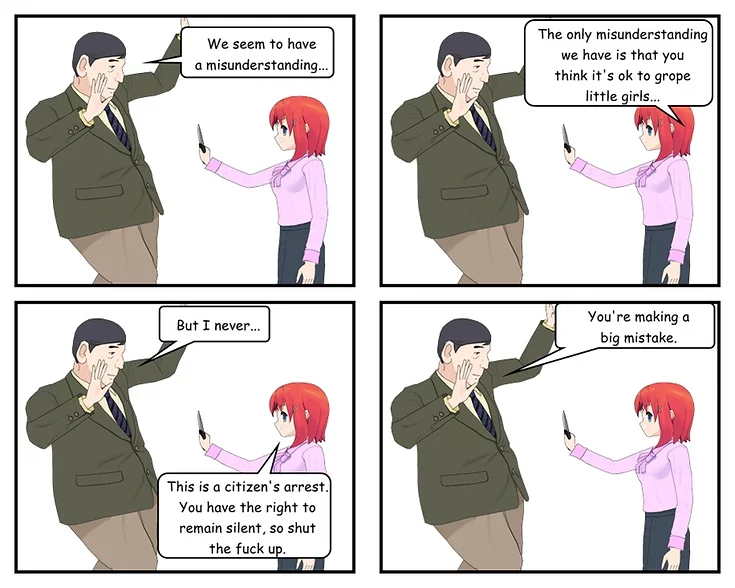Illustrated Series #79
Previous... ...Next

Previous... ...Next
The only misunderstanding is that you think it's ok to grope little girls...by the way, calling the cops won't do you any good because that's the mayor. Messing with Nadia's kids may be even more dangerous than bringing dinosaurs back to life in a de-extinction process, and that's a pretty bad idea.
Bringing dinosaurs back to life, also known as de-extinction, is a concept that has fascinated scientists and the public alike. However, there are several reasons why it might be a bad idea to pursue this technology:
Ecological Disruption: Dinosaurs went extinct millions of years ago, and the world's ecosystems have since evolved and adapted without them. Reintroducing dinosaurs could disrupt the delicate balance of modern ecosystems, potentially leading to the extinction of existing species or causing ecological imbalances. Such disruptions could have far-reaching consequences for the environment, agriculture, and biodiversity.
Ethical Considerations: De-extinction raises ethical questions about the treatment and well-being of resurrected animals. It is uncertain how these animals would adjust to the modern world and whether they could thrive in captivity or in the wild. Additionally, the process of de-extinction itself could involve the use of genetic manipulation and cloning techniques, raising concerns about animal welfare and the potential for unintended consequences.
Safety Concerns: Dinosaurs were apex predators and powerful creatures, many of which could pose a significant risk to human safety if brought back to life. Ensuring the safe containment and management of resurrected dinosaurs would be a considerable challenge, especially if they were to escape or reproduce uncontrollably.
Resource Allocation: De-extinction research requires significant financial and technological resources. These resources could be better allocated to addressing urgent environmental challenges, such as climate change, habitat loss, and the preservation of endangered species. Focusing on de-extinction may divert attention and funding away from more pressing conservation efforts.
Uncertain Benefits: While the idea of resurrecting dinosaurs captures the imagination, the practical benefits of de-extinction are uncertain. Rather than focusing on recreating long-extinct creatures, efforts should be directed towards protecting and preserving the existing biodiversity on our planet.
In conclusion, the idea of bringing dinosaurs back to life may be captivating, but it raises numerous ethical, ecological, safety, and resource allocation concerns. Prioritizing conservation efforts, protecting existing species, and addressing modern environmental challenges are more critical priorities for preserving the planet's biodiversity and ensuring a sustainable future.
Nobody's Property illustrated series is published on nobodysproperty.com by Blake Hutchison dba Sansevieria Media. All rights reserved.
© Nobody's Property Illustrated Series, copyright 2018- | all rights reserved. This illustrated series is for entertainment purposes only. Please do not attempt any homicidal, vigilante, or other illegal acts.